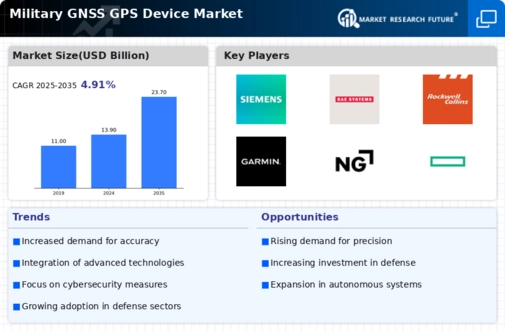Geopolitical Tensions
Geopolitical tensions are a significant driver of the Global Military GNSS GPS Device Market Industry. As nations face increasing security threats, there is a heightened focus on enhancing military capabilities, including navigation systems. Countries are investing in GNSS technology to ensure operational readiness and strategic deterrence. The ongoing conflicts and territorial disputes in various regions underscore the necessity for reliable navigation solutions. This trend is anticipated to contribute to the market's growth, with projections indicating a market size of 23.7 USD Billion by 2035. The demand for advanced GNSS devices is likely to rise as military forces seek to maintain situational awareness.
Increased Defense Budgets
The Global Military GNSS GPS Device Market Industry is experiencing growth due to increased defense budgets across various nations. Governments are allocating more resources to modernize their military capabilities, which includes investing in advanced navigation systems. For instance, in 2024, the market is projected to reach 13.9 USD Billion, driven by countries prioritizing technological advancements in defense. This trend is particularly evident in regions such as North America and Asia-Pacific, where nations are enhancing their military infrastructure to maintain strategic advantages. The emphasis on precision and reliability in military operations further propels the demand for GNSS GPS devices.
Market Growth Projections
The Global Military GNSS GPS Device Market Industry is poised for substantial growth, with projections indicating a market size of 23.7 USD Billion by 2035. This growth trajectory is supported by a compound annual growth rate (CAGR) of 4.94% from 2025 to 2035. The increasing demand for advanced navigation solutions, coupled with rising defense budgets and technological advancements, is likely to drive this expansion. The market's dynamics suggest a robust future, as military organizations worldwide continue to prioritize the integration of GNSS technology into their operations, ensuring enhanced operational effectiveness and strategic capabilities.
Technological Advancements
Technological advancements play a pivotal role in shaping the Global Military GNSS GPS Device Market Industry. Innovations in satellite technology, signal processing, and miniaturization of components are enhancing the performance and capabilities of GNSS devices. These advancements enable military forces to achieve higher accuracy and reliability in navigation and positioning. As a result, the market is likely to witness a compound annual growth rate (CAGR) of 4.94% from 2025 to 2035. The integration of artificial intelligence and machine learning into GNSS systems is also expected to revolutionize military operations, providing real-time data analysis and decision-making support.
Integration with Emerging Technologies
The integration of GNSS GPS devices with emerging technologies is transforming the Global Military GNSS GPS Device Market Industry. The convergence of GNSS with technologies such as drones, autonomous vehicles, and the Internet of Things (IoT) is enhancing operational capabilities. Military applications are increasingly leveraging these integrations for improved reconnaissance, surveillance, and logistics. As the military sector embraces digital transformation, the demand for advanced GNSS solutions is expected to surge. This trend aligns with the projected market growth, as military organizations seek to harness the potential of interconnected systems to enhance mission effectiveness and efficiency.
Demand for Enhanced Navigation Accuracy
The demand for enhanced navigation accuracy is a critical factor driving the Global Military GNSS GPS Device Market Industry. Military operations require precise positioning and timing to ensure mission success. As a result, there is a growing emphasis on developing GNSS devices that can deliver high levels of accuracy, even in challenging environments. This demand is reflected in the market's projected growth, with an expected value of 13.9 USD Billion in 2024. Military forces are increasingly adopting multi-constellation GNSS solutions to improve resilience and reliability, which further fuels the market's expansion as they seek to mitigate risks associated with navigation errors.












